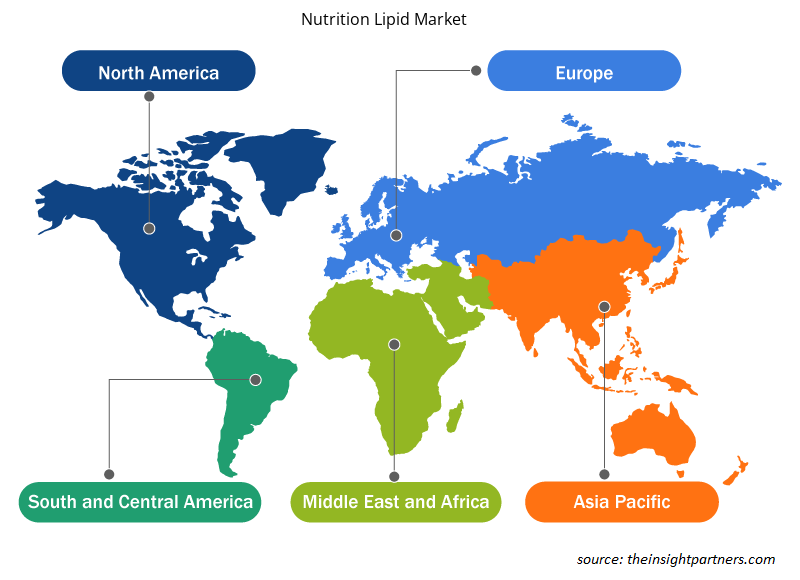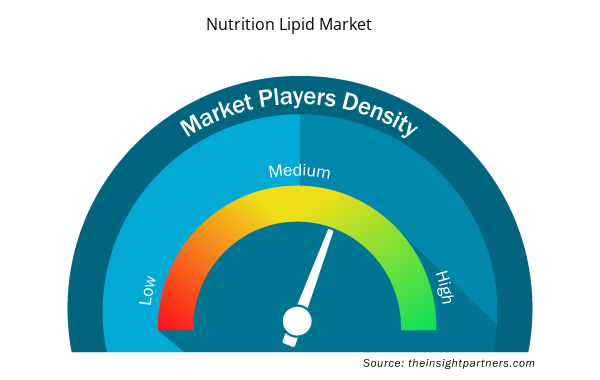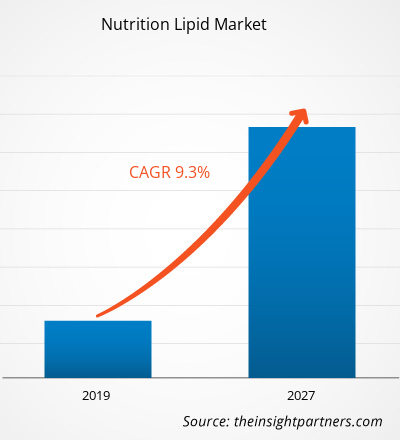[調査レポート] 世界の栄養脂質市場は2018年に7,443.2百万米ドルに達し、2019年から2027年の予測期間中に9.3%のCAGRで成長し、2027年までに16,429.6百万米ドルに達すると予想されています。
アジア太平洋地域は、世界の栄養脂質市場で最大の市場シェアを占めています。この地域の栄養脂質市場の成長は、主に栄養強化機能性食品やサプリメントへの支出の増加に起因しています。さらに、アジア太平洋地域の乳児用食品における栄養脂質の重要性は他に類を見ないものであり、そのためオメガ3製品に対する顕著な需要を生み出しています。消費者の間で栄養脂質の重要性と健康上の利点に関する認識が高まっていることが、この地域の栄養脂質市場の成長の主な原動力です。これは、予測期間中の栄養脂質市場の成長に影響を与えるでしょう。さらに、消費者の購買力の増加は、栄養脂質市場のプレーヤーに有利な成長機会を提供する主な要因です。
要件に合わせてレポートをカスタマイズする
このレポートの一部、国レベルの分析、Excelデータパックなど、あらゆるレポートを無料でカスタマイズできます。また、スタートアップや大学向けのお得なオファーや割引もご利用いただけます。
- このレポートの主要な市場動向を入手してください。この無料サンプルには、市場動向から見積もりや予測に至るまでのデータ分析が含まれます。
市場分析
消費者の間で健康的な食事に対する意識が高まる
健康的な食事は、栄養失調や、心臓病、糖尿病、がんなどの非感染性疾患(NCD)の予防に役立ちます。塩分摂取量を1日5グラム未満に抑えると、高血圧を回避でき、成人の心臓病リスクを軽減できます。世界保健機関(WHO)加盟国は、2025年までに世界の人口の塩分消費量を30%削減することに合意しており、また、2025年に糖尿病と肥満の増加を止めることにも合意しています。栄養脂質は、体の適切な代謝と機能のために、毎日の食事に必要不可欠です。栄養脂質は、人体に正確な利点と機能を持つさまざまな種類の脂肪で構成されています。ただし、栄養脂質は、家畜の製品に含まれる脂質を増やし、ペットの健康を高めるために、動物飼料やペットフードの配合にも使用されています。栄養脂質市場は、世界中の都市部の住民による補助的な食事により成長すると予想されています。栄養脂質市場は、消費者の間で健康的な食事の利点についての認識が高まったことにより進化しています。
新興国における意識の高まりが市場成長の機会をもたらす
栄養脂質市場は、消費者の間で健康的な食事の利点についての認識が高まり、健康への関心が高まっているために台頭しています。機能性食品、医薬品、栄養補助食品などのイノベーションの増加は、新興経済国における栄養脂質の成長機会を生み出しています。アジア太平洋地域やアフリカなどの新興地域では、乳児および女性の栄養市場が成長しています。食品部門への外国直接投資の自由化は、世界の栄養脂質市場に機会を生み出す主な要因です。さらに、サプリメントと機能性食品の需要の高まりとアジアおよびアフリカ地域の可処分所得の増加により、予測期間中に栄養脂質市場の成長が促進されると予想されます。また、オメガ3を含む乳児用食品の需要が新興地域で高まっています。これらの地域の親の間では、乳児の健康的な成長に関するオメガ3の利点に対する認識が高まっています。したがって、これらの要因が市場に機会を生み出すように推進されています。
タイプインサイト
世界の栄養脂質市場は、タイプ別にオメガ3、オメガ6、中鎖トリグリセリド、その他に分類されています。オメガ3栄養脂質セグメントは、世界の栄養脂質市場を支配しています。オメガ3市場は、健康的でバランスの取れた食事とその健康上の利点に関する消費者の意識の高まりなどの要因によって推進されています。また、EPAやDHAなどのオメガ3サプリメントは、結腸がん、前立腺がん、乳がんのリスクを軽減します。十分な量のEPAは、うつ病やその他の健康関連の問題のリスクを軽減します。乳児用調合乳用のオメガ3市場は、中国などのアジア諸国の発展により、パッケージ食品業界で高い成長率を示しています。世界的なオメガ3生産の増加とその需要の増加は、地域全体でのより高い成長の主な理由です。
アプリケーションインサイト
用途に基づいて、世界の栄養脂質市場は、食事、サプリメント、機能性食品、医薬品、乳児用調製粉乳、動物栄養、食品強化、その他に分類されています。用途セグメントでは、食事、サプリメント、機能性食品が世界の栄養脂質市場の主要セグメントです。予防医療の重要性の高まりにより、消費者は毎日の栄養摂取に注意を払うようになりました。これは、世界中で栄養補助食品と機能性食品の摂取に大きく反映されています。栄養補助食品と機能性食品は、関節炎、喘息、がん、糖尿病などの慢性疾患の発症を軽減または予防できます。機能性食品は健康的な成分で作られているため、需要が高まっており、地域全体で大幅に増加しています。天然成分を使用した高タンパク質の食事に対する消費者の好みの高まりも、栄養補助食品と機能性食品の世界市場を牽引しています。
世界の栄養脂質市場で最も採用されている戦略は、合併と買収および研究開発です。世界の栄養脂質市場における最近の動向のいくつかを以下に示します。
2017年:Royal DSMとEvonikは、動物栄養用途の天然海藻由来のオメガ3脂肪酸製品の合弁会社を設立しました。このイノベーションにより、有限資源である天然捕獲魚の魚油を使用せずに、動物栄養用のオメガ3脂肪酸を生産できるようになります。
2017年:シーフードメーカーのCooke Inc.は、特殊油と特殊タンパク質製品を扱う栄養製品会社であるOmega Protein Corporationを買収しました。この買収を通じて、同社は事業の供給側を多様化することで、Cookeの成長戦略のもう1つのプラットフォームを達成することを目指しました。
2018年:BASF ASは、米国でランダム化プラセボ対照臨床試験を完了し、Nutrientsに新たに発表されました。この試験では、非アルコール性脂肪性肝疾患(NAFLD)患者のオメガ3脂肪酸の栄養欠乏を是正するために高濃度オメガ3を使用することを評価しました。
栄養脂質市場の地域別洞察
予測期間を通じて栄養脂質市場に影響を与える地域的な傾向と要因は、Insight Partners のアナリストによって徹底的に説明されています。このセクションでは、北米、ヨーロッパ、アジア太平洋、中東、アフリカ、南米、中米にわたる栄養脂質市場のセグメントと地理についても説明します。

- 栄養脂質市場の地域別データを入手
栄養脂質市場レポートの範囲
| レポート属性 | 詳細 |
|---|---|
| 2018年の市場規模 | 74億4千万米ドル |
| 2027年までの市場規模 | 164.3億米ドル |
| 世界のCAGR(2018年 - 2027年) | 9.3% |
| 履歴データ | 2016-2017 |
| 予測期間 | 2019-2027 |
| 対象セグメント | タイプ別
|
| 対象地域と国 | 北米
|
| 市場リーダーと主要企業プロフィール |
|
栄養脂質市場のプレーヤー密度:ビジネスダイナミクスへの影響を理解する
栄養脂質市場は、消費者の嗜好の変化、技術の進歩、製品の利点に対する認識の高まりなどの要因により、エンドユーザーの需要が高まり、急速に成長しています。需要が高まるにつれて、企業は提供品を拡大し、消費者のニーズを満たすために革新し、新たなトレンドを活用し、市場の成長をさらに促進しています。
市場プレーヤー密度とは、特定の市場または業界内で活動している企業または会社の分布を指します。これは、特定の市場スペースに、その市場規模または総市場価値に対してどれだけの競合相手 (市場プレーヤー) が存在するかを示します。
栄養脂質市場で事業を展開している主要企業は次のとおりです。
- アーチャー・ダニエルズ・ミッドランド・カンパニー
- BASF SE
- クローダインターナショナル
- コーニンクレッカ DSM NV
- ネプチューン ウェルネス ソリューションズ株式会社
免責事項:上記の企業は、特定の順序でランク付けされていません。

- 栄養脂質市場のトップキープレーヤーの概要を入手
世界の栄養脂質市場のセグメンテーション
タイプ別
• オメガ3• オメガ6• 中鎖脂肪酸• その他
アプリケーション別
• 栄養補助食品および栄養補助食品• 医薬品• 乳児用調製粉乳• 動物栄養• その他
ソース別
• 動物• 植物
フォーム別
• 粉末• 液体
地理別
北米
- 私たち
- カナダ
- メキシコ
ヨーロッパ
- フランス
- ドイツ
- イタリア
- 英国
- ロシア
- その他のヨーロッパ
アジア太平洋
- 中国
- 日本
- 韓国
- インド
- オーストラリア
- その他のアジア太平洋地域
中東およびアフリカ(MEA)
- アラブ首長国連邦
- サウジアラビア
- 南アフリカ
- MEAの残り
南アメリカ
- ブラジル
- アルゼンチン
- 南米のその他の地域 (SAM)
企業プロフィール
- アーチャー・ダニエルズ・ミッドランド・カンパニー
- BASF SE
- クローダインターナショナル
- コーニンクレッカ DSM NV
- ネプチューン ウェルネス ソリューションズ株式会社
- ノルディックナチュラルズ株式会社
- オメガプロテインコーポレーション
- ペラギア AS
- ファーママリンAS
- ポラリス
- 過去2年間の分析、基準年、CAGRによる予測(7年間)
- PEST分析とSWOT分析
- 市場規模価値/数量 - 世界、地域、国
- 業界と競争環境
- Excel データセット



Report Coverage
Revenue forecast, Company Analysis, Industry landscape, Growth factors, and Trends

Segment Covered
This text is related
to segments covered.

Regional Scope
North America, Europe, Asia Pacific, Middle East & Africa, South & Central America

Country Scope
This text is related
to country scope.
よくある質問
Merger & acquisition and research & development were observed as the most adopted strategies in global nutrition lipid market. For instance, in 2017 seafood manufacturer Cooke Inc., acquired Omega Protein Corporation which is a nutritional product company dealing in specialty oils and specialty protein products. Through this acquisition, the company aimed to achieve another platform in Cooke’s growth strategy by diversifying in the supply side of the business.
The global nutrition lipids market growth is majorly influenced by determinants such as growing awareness of healthy diet among the consumers and rising awareness in emerging economies provides opportunity for the market growth.
The omega-3 nutrition lipid segment dominated the global nutrition lipid market. The market of Omega-3 is propelled by factors such as an increase in awareness among consumer regarding a healthy & balanced diet and its health benefits. Also, omega-3 supplements such as EPA and DHA lessens the risk of colon, prostate, and breast cancer. The omega-3 market for infant formula witnesses a high growth rate, in the packaged food industry, due to developments in Asian countries such as China.
Based on application, the dietary supplements and nutraceutical is the leading segment in the global nutrition lipid market. The growing importance of preventive healthcare has driven consumers to pay attention to their daily nutritional consumption. The growing consumer preference for high-protein diets with natural ingredients is also driving the global market for dietary supplements and nutraceutical.
The major players operating in the global nutrition lipids market are Archer Daniels Midland Company, BASF SE, Croda International Plc, Koninklijke DSM N.V., Neptune wellness solutions Inc, Nordic Naturals, Inc.; Omega Protein Corporation, Pelagia AS, Pharma Marine AS, Polaris and many others.
In 2020, Asia-Pacific accounted for the largest share in the global nutrition lipids market. The growth of nutrition lipid market in this region is primarily attributed to the rising spending on nutrient-enriched functional foods as well as supplements. Rising awareness related to the importance and health benefits of nutrition lipid among the consumers is the main driver for the growth of nutrition lipid market in the region. Furthermore, increasing spending power among the consumers is the major factor that provides a lucrative growth opportunity for the nutrition lipid market players.
Trends and growth analysis reports related to Food and Beverages : READ MORE..
The List of Companies
- Archer Daniels Midland Company
- BASF SE
- Croda International Plc
- Koninklijke DSM N.V.
- Neptune wellness solutions Inc
- Nordic Naturals, Inc.
- Omega Protein Corporation
- Pelagia AS
- Pharma Marine AS
- Polaris
The Insight Partners performs research in 4 major stages: Data Collection & Secondary Research, Primary Research, Data Analysis and Data Triangulation & Final Review.
- Data Collection and Secondary Research:
As a market research and consulting firm operating from a decade, we have published and advised several client across the globe. First step for any study will start with an assessment of currently available data and insights from existing reports. Further, historical and current market information is collected from Investor Presentations, Annual Reports, SEC Filings, etc., and other information related to company’s performance and market positioning are gathered from Paid Databases (Factiva, Hoovers, and Reuters) and various other publications available in public domain.
Several associations trade associates, technical forums, institutes, societies and organization are accessed to gain technical as well as market related insights through their publications such as research papers, blogs and press releases related to the studies are referred to get cues about the market. Further, white papers, journals, magazines, and other news articles published in last 3 years are scrutinized and analyzed to understand the current market trends.
- Primary Research:
The primarily interview analysis comprise of data obtained from industry participants interview and answers to survey questions gathered by in-house primary team.
For primary research, interviews are conducted with industry experts/CEOs/Marketing Managers/VPs/Subject Matter Experts from both demand and supply side to get a 360-degree view of the market. The primary team conducts several interviews based on the complexity of the markets to understand the various market trends and dynamics which makes research more credible and precise.
A typical research interview fulfils the following functions:
- Provides first-hand information on the market size, market trends, growth trends, competitive landscape, and outlook
- Validates and strengthens in-house secondary research findings
- Develops the analysis team’s expertise and market understanding
Primary research involves email interactions and telephone interviews for each market, category, segment, and sub-segment across geographies. The participants who typically take part in such a process include, but are not limited to:
- Industry participants: VPs, business development managers, market intelligence managers and national sales managers
- Outside experts: Valuation experts, research analysts and key opinion leaders specializing in the electronics and semiconductor industry.
Below is the breakup of our primary respondents by company, designation, and region:

Once we receive the confirmation from primary research sources or primary respondents, we finalize the base year market estimation and forecast the data as per the macroeconomic and microeconomic factors assessed during data collection.
- Data Analysis:
Once data is validated through both secondary as well as primary respondents, we finalize the market estimations by hypothesis formulation and factor analysis at regional and country level.
- Macro-Economic Factor Analysis:
We analyse macroeconomic indicators such the gross domestic product (GDP), increase in the demand for goods and services across industries, technological advancement, regional economic growth, governmental policies, the influence of COVID-19, PEST analysis, and other aspects. This analysis aids in setting benchmarks for various nations/regions and approximating market splits. Additionally, the general trend of the aforementioned components aid in determining the market's development possibilities.
- Country Level Data:
Various factors that are especially aligned to the country are taken into account to determine the market size for a certain area and country, including the presence of vendors, such as headquarters and offices, the country's GDP, demand patterns, and industry growth. To comprehend the market dynamics for the nation, a number of growth variables, inhibitors, application areas, and current market trends are researched. The aforementioned elements aid in determining the country's overall market's growth potential.
- Company Profile:
The “Table of Contents” is formulated by listing and analyzing more than 25 - 30 companies operating in the market ecosystem across geographies. However, we profile only 10 companies as a standard practice in our syndicate reports. These 10 companies comprise leading, emerging, and regional players. Nonetheless, our analysis is not restricted to the 10 listed companies, we also analyze other companies present in the market to develop a holistic view and understand the prevailing trends. The “Company Profiles” section in the report covers key facts, business description, products & services, financial information, SWOT analysis, and key developments. The financial information presented is extracted from the annual reports and official documents of the publicly listed companies. Upon collecting the information for the sections of respective companies, we verify them via various primary sources and then compile the data in respective company profiles. The company level information helps us in deriving the base number as well as in forecasting the market size.
- Developing Base Number:
Aggregation of sales statistics (2020-2022) and macro-economic factor, and other secondary and primary research insights are utilized to arrive at base number and related market shares for 2022. The data gaps are identified in this step and relevant market data is analyzed, collected from paid primary interviews or databases. On finalizing the base year market size, forecasts are developed on the basis of macro-economic, industry and market growth factors and company level analysis.
- Data Triangulation and Final Review:
The market findings and base year market size calculations are validated from supply as well as demand side. Demand side validations are based on macro-economic factor analysis and benchmarks for respective regions and countries. In case of supply side validations, revenues of major companies are estimated (in case not available) based on industry benchmark, approximate number of employees, product portfolio, and primary interviews revenues are gathered. Further revenue from target product/service segment is assessed to avoid overshooting of market statistics. In case of heavy deviations between supply and demand side values, all thes steps are repeated to achieve synchronization.
We follow an iterative model, wherein we share our research findings with Subject Matter Experts (SME’s) and Key Opinion Leaders (KOLs) until consensus view of the market is not formulated – this model negates any drastic deviation in the opinions of experts. Only validated and universally acceptable research findings are quoted in our reports.
We have important check points that we use to validate our research findings – which we call – data triangulation, where we validate the information, we generate from secondary sources with primary interviews and then we re-validate with our internal data bases and Subject matter experts. This comprehensive model enables us to deliver high quality, reliable data in shortest possible time.


 このレポートの無料サンプルを入手する
このレポートの無料サンプルを入手する